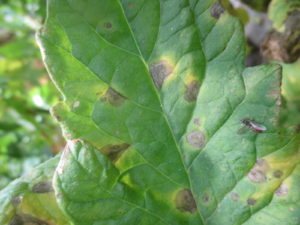The following two articles describe two vegetable diseases new to Indiana that were recorded this past season. While neither of the disease reports are from severe outbreaks, it might be a good idea to become familiar with what may become a new disease situation.
Target spot of tomato was identified from a tomato plant growing in a high tunnel in early July in Carroll County. At first glance, the disease appears to be early blight (Figure 1). Target spot may cause necrotic lesions in a concentric pattern. Although target spot may cause lesions on fruit, we did not observe such lesions. After incubation of the leaves, spores that appeared to be Corynespora cassiicola, causal agent of target spot were observed. This fungus was isolated in our lab and the identity of the fungus was confirmed by sequencing on campus. This is the first report of target spot of tomato in Indiana.
Like charcoal rot, the fungus that causes target spot also has a huge host range including soybeans, cucumber, many ornamental and some weeds. However, there appears to some host specialization in C. cassiicola: strains of the fungus from soybean are more likely to be a problem on soybeans, while strains from tomato are more likely to be a problem on tomato. Target spot of tomatoes is a big problem in Florida. We don’t have any information on the geographical or host origin of the strain that we collected on tomato in Carroll County.

Figure 1. Target spot of tomato often causes necrotic lesions in a concentric pattern, similar to early blight.
Target spot of tomato is favored by temperatures of 68 to 82°F and leaf wetness periods as long as 16 hours. The target spot fungus can survive in host residue for a period. Therefore, it is possible that the target spot fungus could overwinter and cause disease during warm, wet weather in 2019.
Although the target spot fungus has a large host range, the apparent specialization of this fungus makes crop rotation a possible disease management option. Any practice such as adequate crop spacing and pruning that helps to lessen leaf wetness should lessen the severity of target spot of tomato. In greenhouse experiments here at the Southwest Purdue Ag Center, mancozeb products (e.g., Dithane®, Manzate®, Penncozeb®) helped lessen disease severity. Most mancozeb products are labeled for greenhouse or high tunnel use, however, the 5-day Pre-harvest Interval (PHI) would make this product difficult to use during harvest.
If you suspect target spot, be sure to get an official diagnosis.